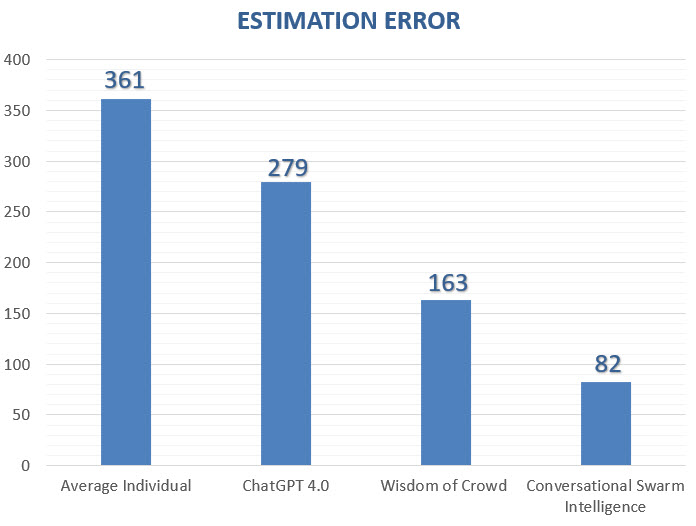
VentureBeat presents: AI Unleashed – An exclusive executive event for enterprise data leaders. Hear from top industry leaders on Nov 15. Reserve your free pass
The word “superintelligence” is thrown around a lot these days, referring to AI systems that may soon exceed human cognitive abilities across a wide range of tasks from logic and reasoning to creativity and intuition. While this seemed like a distant possibility only a few years ago, many experts now believe it could be less than a decade away. This is driving significant concerns among policymakers and researchers, for there’s a real possibility that an artificial superintelligence (ASI) is created that does not share human values, morals, sensibilities or objectives.
To address this risk, some researchers believe they can design AI systems that are inherently aligned with human values and interests. Anthropic, for example, aims to achieve this using a method they call Constitutional AI that instills a set of rules or principles that govern behavior. OpenAI has an alternate approach they call Superalignment, and they are dedicating 20% of their computing power to solving the issue.
While I appreciate all efforts towards AI safety, I worry they could give a fall sense of security, as they promise alignment but cannot predict long-term effectiveness.
This begs the question, is there a safer path to superintelligence?
I believe there is. It’s called Collective Superintelligence (CSi) and it’s been my focus as an AI researcher for the last decade. The goal is not to replace human intellect, but to amplify it by connecting large groups of people into superintelligent systems that can solve problems no individual could solve on their own, while also ensuring that human values, morals and interests are inherent at every level.
VB Event
AI Unleashed
Don’t miss out on AI Unleashed on November 15! This virtual event will showcase exclusive insights and best practices from data leaders including Albertsons, Intuit, and more.
This might sound unnatural, but it’s a common step in the evolution of many social species. Biologists call the phenomenon Swarm Intelligence and it enables schools of fish, swarms of bees and flocks of birds to skillfully navigate their world without any individual being in charge. They don’t do this by taking votes or polls the way human groups make decisions. Instead, they form real-time interactive systems (that is, swarms) that push and pull on the decision-space and converge on optimized solutions.
If this works for bees and fish – why not people?
That question inspired me a decade ago to start researching if human groups could be connected into superintelligent systems. To explore this, I founded Unanimous AI in 2014 and we got to work emulating biological swarms. Our early techniques were entirely non-verbal, allowing hundreds of networked users to answer questions by collaboratively controlling a graphical puck with mice or touchscreens while AI algorithms observed their behaviors and inferred their relative levels of conviction.


We used this graphical method to enable groups to collaboratively answer simple questions such as forecasting future events. To our surprise, it significantly amplified intelligence. It worked so well in fact, some journalists were skeptical and challenged us to make public forecasts. For example, I was famously asked by a CBS reporter in 2016 to predict the Kentucky Derby — not just the winner of the race, but the first four horses in order. What happened next was remarkable.
The reporter went to the Kentucky Derby, placed a bet on the four horses, and immediately tweeted a picture of her receipt for the world to see. The next day, Newsweek reported: “AI turns $20 into $11,000 on Kentucky Derby Bet.” Of course, there was some luck involved, but beating 540-to-1 odds was not random chance. It was the power of connecting a human group into a real-time system that amplified their combined intelligence. Over the years since, Swarm AI has been validated by dozens of academic studies, demonstrating value in applications from financial forecasting to medical diagnosis.
Still, building a Collective Superintelligence seemed out of reach. That’s because prior methods only worked for narrowly defined problems. To create a true superintelligence powered by humans, the technology would need to be far more flexible, allowing large groups to deliberate complex issues by leveraging the most powerful human invention of all — language.
But how can you enable hundreds, thousands, or even millions of individuals to hold real-time conversations that are thoughtful and coherent and converge on solutions that amplify their collective intelligence?
The core problem is that human conversations are most productive in groups of 4 to 7 and quickly degrade as groups grow larger. This is because the “airtime per person” gets progressively reduced and the conversational dynamics change from thoughtful debate to a series of monologues that become increasingly disjointed. This size limitation for human conversations seemed like an impenetrable barrier in building a true Collective Superintelligence until about 18 months ago when advances in the field of AI, including large language models (LLMs), opened new pathways for architecting human swarms.
The resulting technology is called Conversational Swarm Intelligence (CSI) and it promises to allow groups of almost any size (200 people, 2,000 people, 2 million people) to discuss complex problems in real-time and converge on meaningful solutions that are amplified by the natural power of swarm intelligence.
The breakthrough was inspired by fish
That’s because fish schools can hold real-time “conversations” among thousands of members, making rapid decisions as they navigate the ocean without any individual in charge. Each fish communicates with others around it using a unique organ called a “lateral line” that senses pressure changes in the water from neighboring fish. Each fish only interacts with a small subgroup, but because all subgroups overlap, information quickly propagates across the full population, enabling a unified intelligence to emerge.
Can we enable conversational swarms in humans? It turns out, we can by using a concept developed in 2018 called hyperswarms that divides real-time human groups into overlapping subgroups. For example, we can take a large group of 1,000 networked individuals and divide them into 200 groups of five people, the members of each subgroup placed into their own small chat room or videoconference. And, if we provide them all with the same problem to solve, we now have 200 parallel conversations, each reasonably sized for thoughtful deliberations.
Of course, enabling parallel groups is not enough to create a Swarm Intelligence. That’s because information needs to propagate across the population. This was solved using AI agents to emulate the function of the lateral line organ in fish.
In particular, LLM-powered Observer Agents were inserted into each of the subgroups and tasked with distilling the real-time human insights within that group and expressing those insights in neighboring groups through first-person dialog. In this way, each subgroup is given an artificial member that joins the conversation as a surrogate for a neighboring group, enabling information to propagate smoothly across the full population. This can be diagrammed as follows.


But does this amplify intelligence?
To test this, researchers recently conducted a study that emulates a 1906 experiment by Sir Francis Galton in which 800 people at a livestock fair were asked to estimate the weight of an ox. He discovered that individuals were wildly varied in their predictions, but the statistical mean was extremely accurate. This has proven repeatable and is now commonly called the Wisdom of Crowds. To emulate this famous study, and avoid needing a live ox, modern researchers often ask groups to estimate common items, like the number of jellybeans in a bowl or gumballs in a jar.


That’s precisely what was conducted to test the intelligence benefits of conversational swarms. As a baseline, 240 people were shown a photograph of a jar full of gumballs and asked to estimate the quantity in an online survey. This was compared to the same group using a prototype CSI platform called Thinkscape. It automatically divided the 240 people into 47 overlapping subgroups of five or six, each subgroup populated with an AI agent.
The conversational group was given four minutes to deliberate by text-chat and converge on an answer. And finally, for completeness, the same photo was uploaded to ChatGPT 4.0 which was asked to make its own AI estimate of gumballs in the jar.
The results were fascinating
Looking first at the survey responses, the average individual was off by 361 gumballs, a 55% error with respect to the correct answer of 659. Remarkably, ChatGPT was better than the typical human, coming within 279 gumballs, a 42% error.
This confirms that pure AI systems are making real progress towards superhuman intelligence. Fortunately, we humans may have a way to stay ahead of the machines — collective intelligence. That’s because when the 240 surveys were aggregated into a statistical mean (using Galton’s 1906 technique), the group came within 163 gumballs of the correct answer, an error of 25%, which was far better than ChatGPT (for now).


Of course, the main purpose of this new study was to assess how the conversational swarm performed. It turns out, millions of years of evolution pointed us in the right direction, for CSI was the best method tested, coming within 82 gumballs of the correct answer, an error of only 12%. This was a statistically significant outcome (p<0.001) and suggests CSI can be used to amplify the intelligence of large groups through real-time deliberations.
While this study used text-chat, the core methods can be deployed for voice-chat, video-chat and VR-chat environments, enabling groups of nearly any size to hold coherent real-time conversations that amplify their collective intelligence. And looking further ahead, if brain-to-brain interfaces are deployed — and many are working on this — I predict the architecture of CSI will offer fundamental value, enabling collective minds to scale to any size.
Why is this important?
In the short term, CSI technology enables an entirely new form of communication in which thoughtful deliberations can be conducted among groups of nearly any size. This has potential to enhance a wide range of fields from enterprise collaboration and market research to large-scale civic engagement.
In the longer term, this approach could enable a new pathway to superintelligence that is inherently aligned with human values, morals and sensibilities. Of course, companies like OpenAI and Anthropic should keep working around the clock to instill their AI models with human values and interests, but others should be pursuing alternative methods that amplify rather than replace human intelligence. One alternative is Collective Superintelligence, which looks far more feasible today than in years past.
Louis Rosenberg is a longtime technologist in the fields of AI and VR. He is known for founding early VR company Immersion in 1993, Unanimous AI in 2014, and for developing the first mixed reality system as a researcher for the U.S. Air Force.
DataDecisionMakers
Welcome to the VentureBeat community!
DataDecisionMakers is where experts, including the technical people doing data work, can share data-related insights and innovation.
If you want to read about cutting-edge ideas and up-to-date information, best practices, and the future of data and data tech, join us at DataDecisionMakers.
You might even consider contributing an article of your own!






